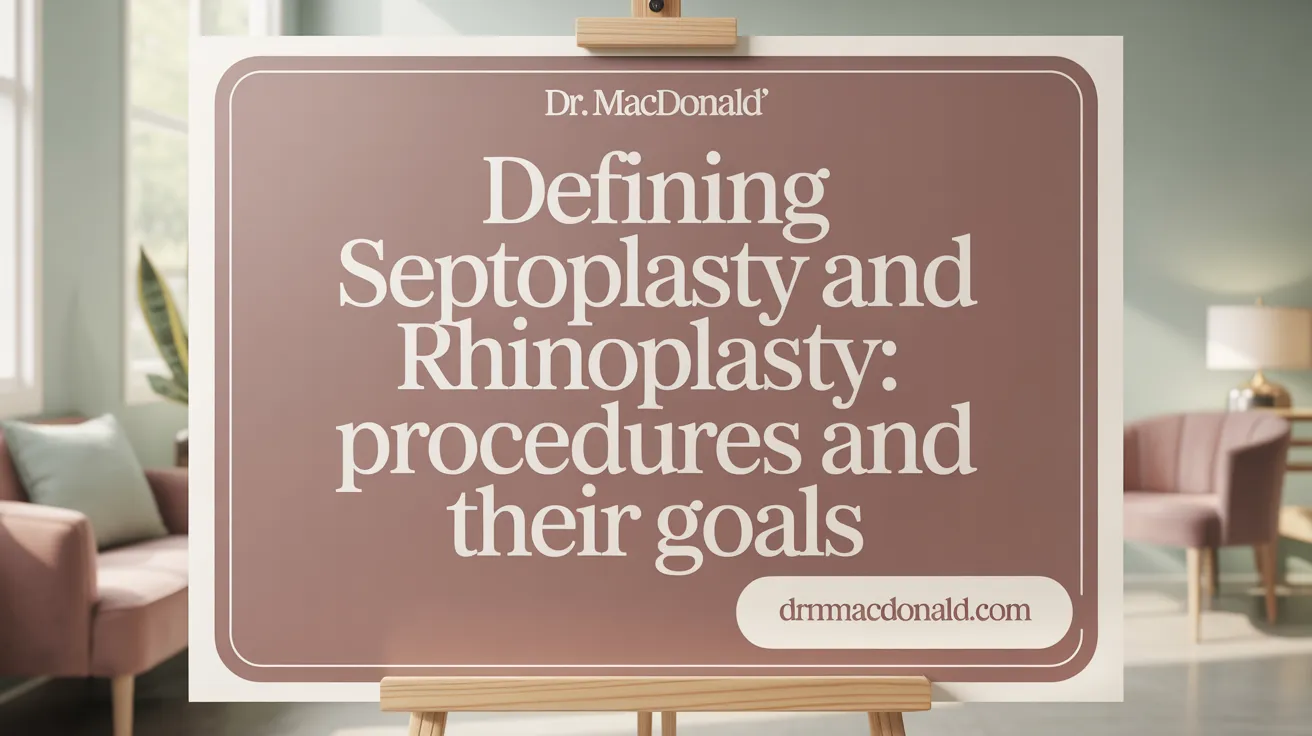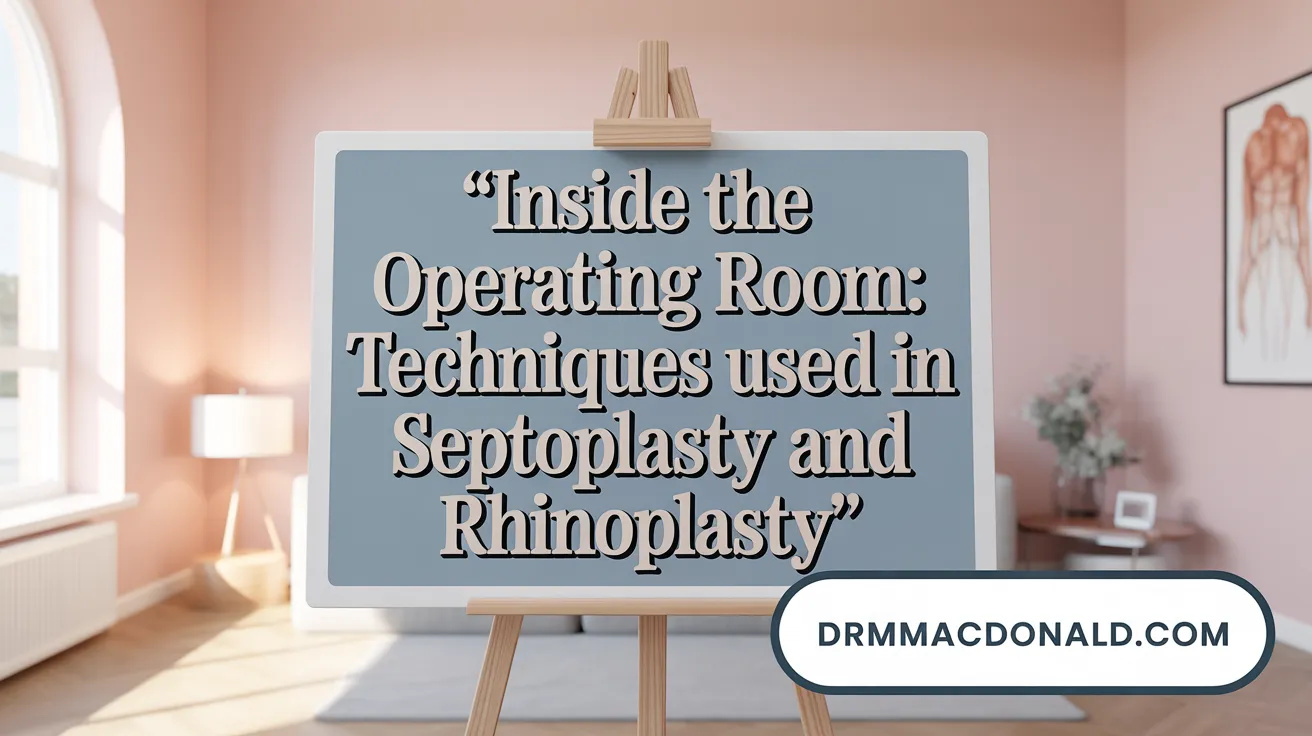Introduction to Nasal Surgery Options
When considering nasal surgery, it's essential to understand the differences between septoplasty and rhinoplasty. These procedures serve unique purposes — from improving breathing to enhancing facial appearance. This article will guide you through everything you need to know about these surgeries, their techniques, benefits, risks, recovery, and decision-making factors to help you make an informed choice.
What Are Septoplasty and Rhinoplasty? Defining the Procedures and Their Purposes

What is septoplasty and what conditions does it address?
Septoplasty is a surgical procedure that corrects a deviated or crooked nasal septum—the wall of bone and cartilage that divides the two nostrils. It primarily aims to improve nasal airflow by straightening this interior partition.
The conditions addressed by septoplasty include nasal airway obstruction, difficulty breathing, recurrent nosebleeds, sinus problems, and issues such as sleep apnea or snoring caused by a septal deviation.
During the surgery, the surgeon makes an incision inside the nose, then trims, repositions, or reconstructs parts of the cartilage and bone to straighten the septum. This results in better airflow, reduced nasal congestion, and relief from breathing difficulties.
Most septoplasties are performed as outpatient surgeries and can be combined with other procedures, like rhinoplasty or sinus surgery, depending on the patient's needs.
What is rhinoplasty and what are its common indications?
Rhinoplasty, often called a “nose job,” is a cosmetic surgical procedure that reshapes the nose to improve appearance or address structural issues.
It involves altering the size, shape, or symmetry of the nose, as well as fixing deformities caused by injury, congenital factors, or previous surgeries.
Common reasons for rhinoplasty include enhancing facial harmony, repairing crooked or damaged noses, narrowing or widening the nasal bridge, refining the nasal tip, or reducing bumps.
Rhinoplasty can also be performed for functional reasons, such as improving breathing difficulties caused by structural abnormalities like a deviated septum.
Surgeons may use open or closed techniques, depending on the extent of reshaping needed. Ultimately, rhinoplasty aims to boost confidence by achieving a balanced and natural-looking nose.
Primary goals of each surgery
| Surgery Type | Main Focus | Goals | Typical Outcomes |
|---|---|---|---|
| Septoplasty | Internal nasal structure | Correct deviated septum, improve breathing | Better airflow, reduced congestion |
| Rhinoplasty | External nose appearance | Reshape or resize the nose, address aesthetic concerns | Improved facial harmony, enhanced confidence |
In some cases, these procedures are combined into a single operation called septorhinoplasty, to address both internal and external nasal concerns simultaneously.
Both surgeries are performed by trained specialists, involve general anesthesia or sedation, and usually have a recovery period of about one week for most activities. Risks include bleeding, infection, and dissatisfaction with cosmetic results, but with proper care, they are considered safe and effective.
Comparing Septoplasty and Rhinoplasty: Key Differences in Purpose and Surgical Approaches
What are the main differences between septoplasty and rhinoplasty in terms of purpose and surgical approach?
Septoplasty and rhinoplasty are two distinct nasal surgeries that serve different main purposes but can also be combined.
Septoplasty’s primary goal is to correct a deviated septum, which is the displacement of the cartilage and bone inside the nose. This procedure mainly aims to improve airflow, helping to relieve breathing problems such as nasal congestion, snoring, sleep apnea, and sinus infections. It addresses internal nasal structures by making incisions inside the nostrils, then straightening, trimming, or repositioning nasal cartilage and bone.
In contrast, rhinoplasty is largely a cosmetic operation designed to modify the external appearance of the nose. It involves reshaping the bone, cartilage, and skin to alter the nose’s size, shape, or symmetry. While it can also resolve some internal issues affecting breathing, its primary purpose is aesthetic enhancement.
The surgical approaches differ significantly:
- Septoplasty utilizes internal incisions without visible scarring, focusing inside the nose.
- Rhinoplasty involves both internal and external incisions, often on the columella (the tissue between the nostrils), to access and reshape nasal structures.
Both procedures can be combined in a single operation called septorhinoplasty, which addresses both aesthetic and functional issues. This combined surgery is efficient, reduces overall recovery time, and gives comprehensive correction.
In summary, septoplasty targets internal structures to improve breathing, while rhinoplasty emphasizes external facial aesthetics. Their techniques are tailored to these different goals, making each procedure unique in approach but sometimes performed together for optimal results.
Surgical Techniques and What to Expect in the Operating Room

What are the typical techniques used in septoplasty and rhinoplasty surgeries?
In septoplasty, surgeons usually make an incision inside the nostrils, which allows access to the nasal septum— the thin wall of cartilage and bone dividing the nasal passages. The correction involves straightening or removing parts of the deviated septum, then repositioning and stabilizing it with sutures and sometimes internal splints to support the new alignment.
Rhinoplasty techniques differ depending on the desired outcome and whether an open or closed approach is chosen. Closed rhinoplasty involves incisions made within the nostrils, leaving no visible scars. In contrast, open rhinoplasty includes a small external incision across the columella, the tissue between the nostrils, which provides the surgeon with better visibility and access to reshape nasal bones, cartilage, and tissue for precise modifications.
Both procedures might incorporate grafting, where tissue is added or reinforced using cartilage taken from within the nose, ear, or rib. These grafts help support or sculpt specific areas, like the nasal tip or dorsum. Additionally, in rhinoplasty, controlled fractures known as osteotomies are often performed to reshape or narrow the nasal bones, helping create a more harmonious facial appearance.
These surgical techniques are designed to address a range of concerns—from improving nasal airflow to achieving a desired aesthetic look. Success depends on the surgeon's skill in combining these methods to meet individual patient needs, balancing functional improvement with aesthetic enhancement.
Benefits, Risks, and Recovery: What Patients Should Know

What are the potential benefits and risks associated with septoplasty and rhinoplasty?
Septoplasty primarily improves nasal airflow by correcting a deviated septum, which can lead to easier breathing, fewer sinus infections, and better sleep. It can also help reduce snoring and sleep apnea symptoms. The risks include bleeding, infection, persistent nasal obstruction, septal perforation, or a change in the sense of smell. Rhinoplasty is mainly performed to enhance facial aesthetics, such as reducing a bump on the bridge, refining the nose tip, or correcting asymmetry. It can also address functional issues like breathing difficulties if internal structures are involved. Common risks involve dissatisfaction with the cosmetic outcome, scarring, swelling, asymmetry, or breathing problems. When combined in septorhinoplasty, these benefits and risks are managed together, often leading to a more comprehensive improvement in both appearance and function.
Both surgeries are usually safe when performed by experienced surgeons. The potential for complications exists but is minimized with proper care. Combining these procedures can be cost-effective and reduce overall recovery time since they are performed together under anesthesia.
What is the typical recovery process like after septoplasty and rhinoplasty?
Recovery from septoplasty generally takes about one to two weeks. Patients often experience mild swelling, nasal congestion, and minor discomfort during this period. Most can return to light activities within this timeframe, but strenuous exercise or heavy lifting should be avoided for at least a month. Nasal splints or packing are usually removed within the first week, and follow-up visits are scheduled to monitor healing.
Rhinoplasty recovery is more prolonged. Visible swelling and bruising tend to subside within two weeks, but subtle swelling can persist for up to a year. Patients are advised to keep their head elevated, avoid blowing their nose, and refrain from vigorous activity during the initial healing phase. Complete healing of the nasal tissues and final aesthetic results can take several months, with the smallest imperfections often fading over time.
Postoperative care recommendations
To facilitate healing and minimize risks, patients should follow their surgeon’s postoperative instructions carefully. This includes keeping the head elevated to reduce swelling, avoiding strenuous activities, and refraining from smoking. Maintaining cleanliness to prevent infection and attending all follow-up appointments are essential. If experiencing unusual symptoms such as heavy bleeding, severe pain, fever, or difficulty breathing, patients should seek medical attention promptly.
Including proper care routines and realistic expectations helps ensure a smooth recovery and optimal long-term results from both septoplasty and rhinoplasty procedures.
Choosing the Right Surgery: Decision Factors and Combining Procedures
When should I consider septoplasty or rhinoplasty, or both?
Deciding between septoplasty, rhinoplasty, or a combination depends on your main concerns—either breathing problems, aesthetic desires, or both. Septoplasty is best suited if you suffer from nasal airflow issues like congestion, sinus problems, or sleep disturbances caused by a deviated septum. Its focus is on improving internal nasal function without necessarily changing the nose’s external appearance.
Rhinoplasty, on the other hand, is often chosen for those seeking to enhance the external look of their nose, such as reducing bumps, adjusting the tip, or reshaping the nose for better facial harmony. It can also be used after trauma or for reconstructive purposes.
If both your breathing and appearance are problematic, combining the procedures into a septorhinoplasty allows for correction of internal and external issues in a single surgery, offering a more comprehensive improvement.
A thorough consultation with a qualified specialist is crucial to determine the most suitable approach based on your unique symptoms, facial structure, and personal goals.
Final Thoughts on Septoplasty and Rhinoplasty
Both septoplasty and rhinoplasty are valuable surgical options tailored to distinct but sometimes overlapping nasal concerns — breathing functionality and cosmetic appearance. Understanding their differences in goals, techniques, benefits, risks, and recovery is crucial for making informed decisions. Many patients benefit from combined procedures that address both airway function and aesthetics in a single surgery, optimizing results and convenience. Consulting a qualified surgeon to evaluate your specific needs will ensure the chosen approach aligns with your health and cosmetic goals, providing the best possible outcome for nasal function and facial harmony.
References
- Rhinoplasty and Septoplasty Difference
- Do I Need a Septoplasty or Rhinoplasty? What's the ...
- Septoplasty vs. Rhinoplasty: Which One Is Best For Me?
- Septoplasty vs. Rhinoplasty: Key Differences Explained
- Septoplasty vs. Rhinoplasty: 5 Differences To Know
- Septoplasty vs Rhinoplasty: 5 Key Differences Explained
- What's the Difference Between Rhinoplasty and Septoplasty?
